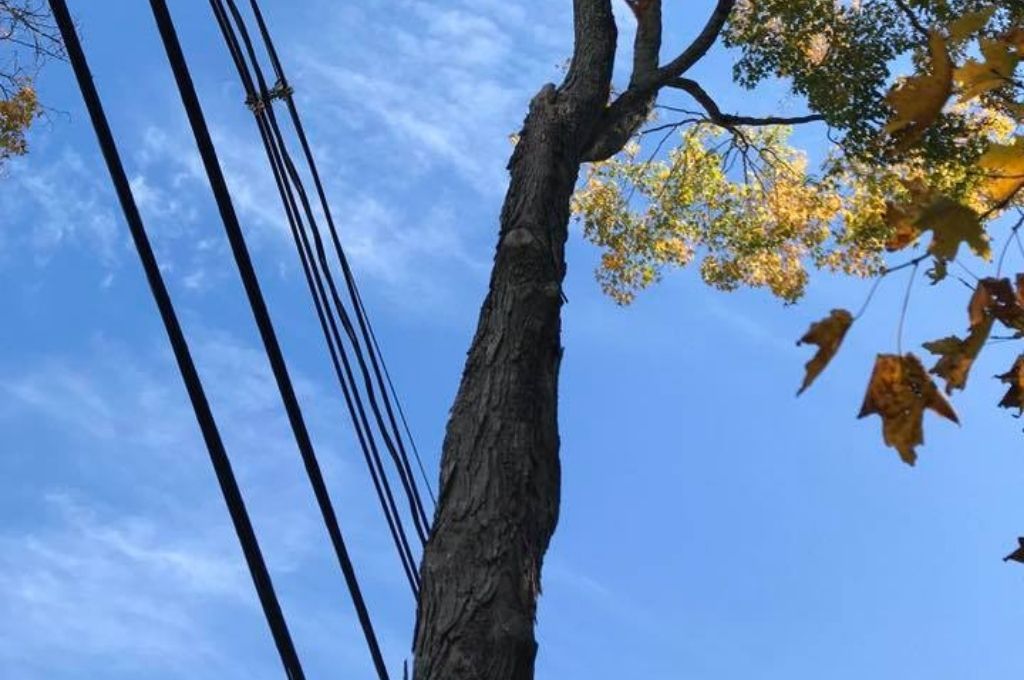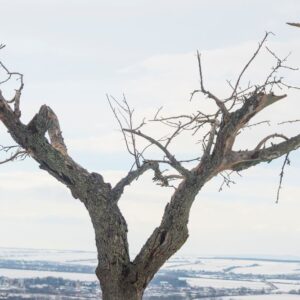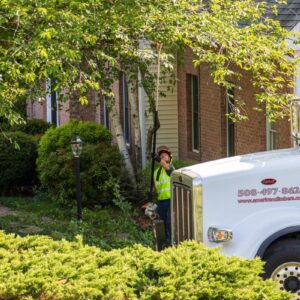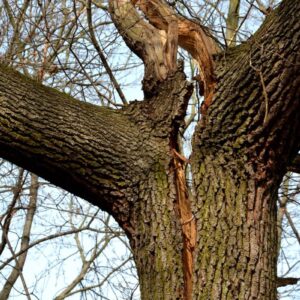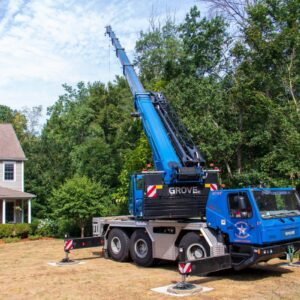Trees and power lines are never a good combination, so you need to put some thought into removing trees near power lines.
Most tree worker deaths and injuries are due to electric shock – but not from touching the wire itself. Instead, this most often comes from a secondary source, such as when a tree branch or pruning tool touches a wire. No matter if the wire is a higher-voltage line at the top of a utility pole (a primary line), a smaller distribution line (a secondary line), or the wire directly to your house (the service line), the danger is still present – and can be fatal.
Because of the dangers associated with power and utility lines, extreme care, caution, and planning must be taken when working around them, including when removing a tree near a power line.
In this article, we explain how tree removal is impacted by the danger associated with power lines, including:
- why working near power lines can translate into longer work times for tree removal jobs,
- how nearby electrical and utility lines affect how trees are removed, and
- why the presence of nearby power lines can cause delays in tree removal work for property owners.
Removing Trees Near Utility Lines Should Never Be a DIY Project
Here in Massachusetts, it’s safe to say that we have a lot of trees. We’re sixth in the nation for tree cover, after all. With more than 7 million trees to contend with, there’s a good chance that one of those will come close to your utility or power lines.
If you find yourself in that situation, you might be tempted to try to cut the tree or even just trim a few branches yourself. “It’s just a couple of limbs,” you might think. “What’s the harm?”
The reality is that removing trees or even just a few branches near a utility line is extremely dangerous. It requires precise work, knowledge, and experience.
The Risk of Electrocution When Working Near Power Lines
Even if you’re an expert DIY-er, a lot can go wrong when you’re working in these sensitive areas. For example, your pole pruner could slip and touch the lines (you may not even see the secondary line in the tree’s canopy until it’s too late), causing you to be electrocuted. And if you’re on a ladder or have climbed the tree (which we never recommend!), the risk is even worse – if the shock isn’t fatal, the fall likely will be.
Primary lines have voltages ranging from 2,300 to 39,000 volts, while typical secondary voltages are between 120 volts to 480 volts, and service lines usually run at 120 or 240 volts. But don’t think that working on the trees or shrubs near your home’s service line is safer than working near the high voltage secondary distribution lines on the pole by the street. That’s simply not true. A common “house drop” (service wire) carries 240 volts and 20 amps or more; that’s more than enough to kill you if you make contact with the line.
Any type of tree work within 10 feet of power lines can be fatal – it doesn’t have to be a direct contact. In some cases, even working as far as 15 feet away can be dangerous.
That’s because electricity can arc from the power line to the tree. It doesn’t usually happen under normal conditions, but if there is a voltage surge, the electricity can kill you if you’re in or near the tree.
Even if the tree doesn’t appear to be touching the powerline, arcs can and do still happen. Not only that, but during tree removal, it is entirely possible that the tree could fall into or brush against the line and conduct electricity. The tools used in tree removal, like chainsaws, can make contact and conduct electricity, too.
From 2009 to 2014, electrocution caused a whopping 17% of fatalities among tree care workers. That’s a high percentage – especially when you consider that these are people who have the skills, tools, and training (along with an understanding of the proper safety precautions) to avoid such catastrophes.
Don’t risk it. Let a tree care company take care of this dangerous task for you.
It Can be Illegal for You to Trim or Remove Trees Near Power lines
In Massachusetts, removing or trimming trees within 10 feet of primary power lines is illegal unless you are an OSHA-certified line clearance worker. That’s because it’s not only dangerous for the worker but it can also disrupt the power source for many other buildings and properties.
In contrast, you (the property owner) are responsible for regularly maintaining the trees on your property to prevent interference with the service line that runs from the utility pole to your home or business. But that doesn’t mean you should do the work yourself!
When in doubt, hire it out!
Types of Utility/Power Lines
It isn’t just electric lines that you need to be careful around. There are other types of power lines that can be potentially dangerous.
These might include:
- Gas lines
- Electric lines
- Ethernet and fiber optic cables
- Telephone or communication cables
Some utility lines are found buried underground but others run above ground from the utility pole to your house. Regardless of the location, they can all be dangerous. For example, removing a tree stump when there are underground gas or utility lines nearby can cause a gas explosion or fire. That’s why it is so important to leave trees to the professionals if they’re near utilities.
Who Is Responsible for Removing Trees Near Power Lines?
If you’ve noticed a tree branch touching or lying in close proximity to the power lines, you might have some anxiety about it – and for good reason. A tree branch can move quite a bit in the slightest breeze and cause power or utility lines to snap if it falls.
If the tree is located on public property, then it’s up to the power company to remove (or trim) it. Utility companies will often ask homeowners for their permission to remove trees near power or utility lines that they consider potentially dangerous. According to Massachusetts tree cutting laws, the utility companies need to contact you first. If the homeowner (you) says no, then the utility may have to make drastic pruning cuts to clear the line.
If the tree is on your land and threatening the lines, then it is your responsibility to have it trimmed or removed. Again, you should not do this yourself! This responsibility just means that you are the one who needs to schedule and pay for the tree’s removal.
Plan Ahead For Tree Removal Near Utility Lines
Plan ahead for tree removal near utility lines and don’t wait until the last minute. It takes a bit of time and forethought to remove these trees, since your tree removal company (like American Climbers) may have to work with the utility company to arrange for the power to be turned off. Depending on where the lines are in the tree canopy, the line(s) may also need to be disconnected from the pole or the panel on your house.
Other tree-cutting preparations often have to be made as well.
This can cause delays that you probably don’t want to deal with if the branches are hanging precariously close to the utility lines!
How Trees Near Power Lines Are Removed
There are a few different ways that tree care companies will remove trees near power lines, including using a crane or bucket truck, or climbing the tree and taking it down in pieces. The method used depends on:
- where your tree is located,
- where the power lines are (both those near your tree and those in the surrounding area),
- what type of power lines are near the tree (primary, secondary, or service lines),
- the condition of your tree,
- access for heavy equipment, and more.
If you schedule an appointment with American Climbers, we’ll inspect your tree(s) and property and recommend the best method for your specific situation.
Using a Crane to Remove Trees Near Power Lines
Using a crane is necessary for situations where a tree or a limb cannot be lowered to the ground because there are objects in the way (like a house). If the tree is dangerous to climb, a crane might be used, too.
To remove a tree with a crane, a climber will typically enter the tree to tie a cable that will connect the tree trunk or branch to the crane ball. Then, he or she will climb down into a safer position to make a cut that will release the trunk or limb from the tree. The crane will then lift away the tree parts in a controlled fashion, and lower them into a clear area or a log truck.
However, using a crane isn’t always the perfect solution. If there are other power lines in the area, buildings, or other structures blocking access, or if there’s no space in which to “park” and stabilize the crane, then other removal methods may be a better choice. As you might expect, it can also be dangerous and requires precise work as workers can still be electrocuted if they aren’t careful.
Using a Bucket Truck to Remove Trees Near Power Lines
Bucket trucks are used more often than cranes to remove trees near power lines, in part because they can stay beneath primary (and, sometimes, secondary) lines.
But again, they aren’t always the perfect solution.
- Operators need to be careful not to drop limbs onto the lines or make contact with the boom or bucket.
- Tree workers have to be precise in their cuts and movements (one slip of the chainsaw can have disastrous effects if it hits a power line).
- The ground crew has to be aware of potential electrical threats at all times (even a branch that’s being lowered to the ground can conduct electricity if the branch tip or lowering rope contact a live wire).
- Sometimes the tree can’t be reached with a bucket truck.
- Plus, bucket trucks can become electrified if any part touches a live wire, injuring or killing the operator inside or the tree worker in the bucket.
Climbing the Tree to Remove It
In cases where a tree cannot be safely reached with heavy equipment, a climber will need to ascend the tree, cut it into pieces, and lower or drop each piece individually. The ground crew will then drag or carry away the pieces.
This often takes longer than using a crane or bucket truck but can be safer when there are many electrical wires in the area.
What to Do if a Tree (or Branch) Falls on Power Lines
First, don’t approach. Downed trees that are entangled in power lines are an electrocution and fire hazard. Live wires that are tangled in branches can also transmit a charge to the surrounding ground, meaning you may be electrocuted even if you don’t directly touch or walk on the downed lines.
After a storm, any downed wires – whether they’re for your electric lines, television, fiber optic, cable, or anything else – should be considered energized and dangerous. Your best course of action is to stay away until you know the area is clear.
Not only that but fallen trees and branches are unstable and could shift or fall without warning.
Contact the power company to shut off the service. It’s a good idea to have the number for your power company on hand. Depending on your location, it’s either Eversource Energy at 800-662-7764 or National Grid at (617) 515-8613.
You can also report a power outage here.
After that, call a local tree service company to remove the downed tree. They’ll check with the utility company to make sure that the power is off, and will then remove the tree for you. If you want, they can also remove the tree stump.
See Storm Damaged Tree Removals are for Experts: Here’s Why
Need a Hand?
If you have a tree near power or utility lines that needs to be removed, contact American Climbers to schedule your tree assessment. You can reach us at 508-497-8628 or use our online form to request a quote.
Remember that due to the dangerous nature of the work involved, removing any tree near a power line can take significantly longer than other tree removals.
We hope this article has made it clear why it may take longer, and appreciate your patience as we perform these difficult and dangerous tree removals.
Blog Topics
Recent Posts
What's Happening? Stay Informed!
Stay on top of local events, pest and disease updates, tree and landscape tips, and more. Delivered straight to your inbox each month.


